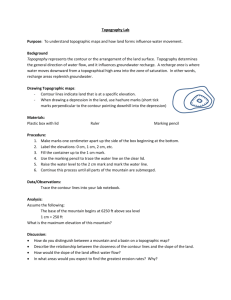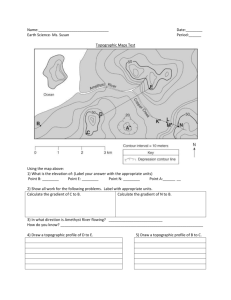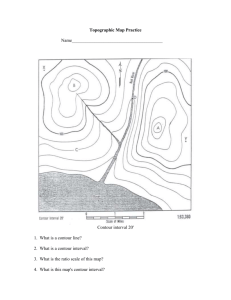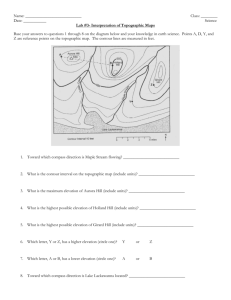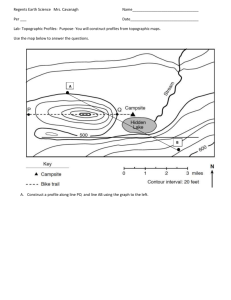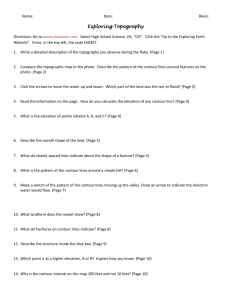Parts of A Topographic Map ws for pp 2011
advertisement
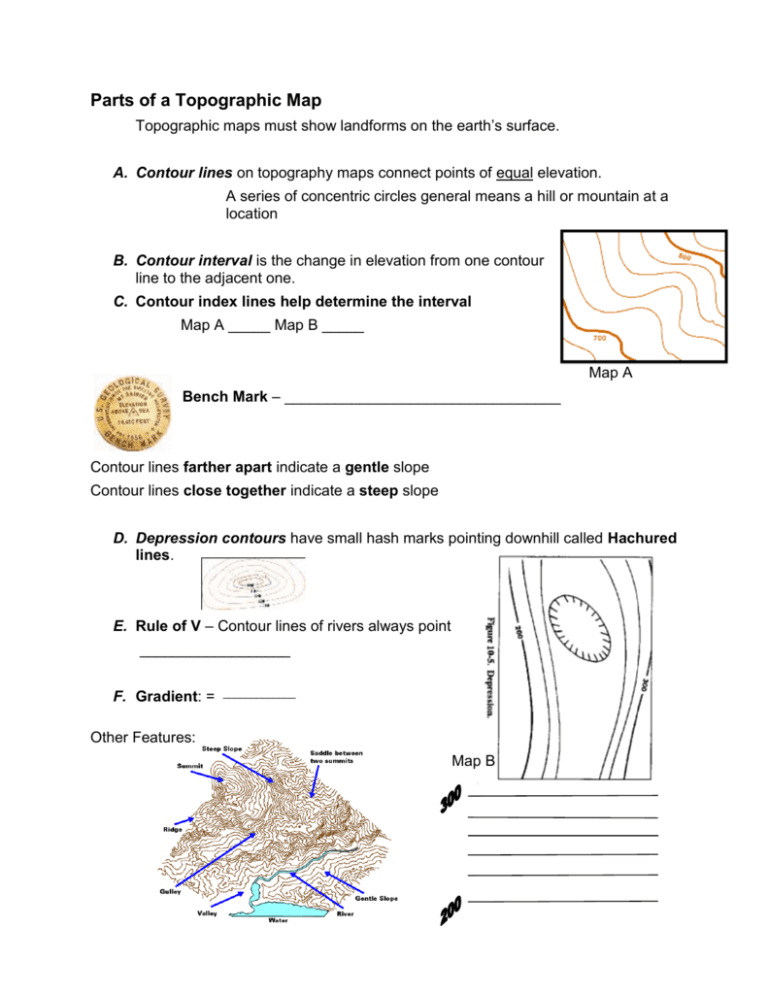
Parts of a Topographic Map Topographic maps must show landforms on the earth’s surface. A. Contour lines on topography maps connect points of equal elevation. A series of concentric circles general means a hill or mountain at a location B. Contour interval is the change in elevation from one contour line to the adjacent one. C. Contour index lines help determine the interval Map A _____ Map B _____ Map A Bench Mark – _________________________________ Contour lines farther apart indicate a gentle slope Contour lines close together indicate a steep slope D. Depression contours have small hash marks pointing downhill called Hachured lines. E. Rule of V – Contour lines of rivers always point __________________ F. Gradient: = _____________ Other Features: Map B 1. Color the elevations on the topographic map as follows. Red: 50m and higher, Orange: 40-50m, Yellow: 30-40m, Light green: 20-30m, Dark green: 10-20m, Purple: 0-10m. 2. Approximately how tall is Able Hill? 3. Approximately how tall is Baker Hill? ___________________________ ___________________________ 4. Which mountain is taller, and by about how much? ___________________________ 5. How many meters of elevation are there between contour lines on the topographic map? 6. Which mountain has steeper slopes? ___________________________ ___________________________ 7. Are the contour lines closer together on Able Hill or Baker Hill? ___________________________ 1. Color the elevations on the topographic map as follows. Red: 50m and higher, Orange: 40-50m, Yellow: 30-40m, Light green: 20-30m, Dark green: 10-20m, Purple: 0-10m. 2. Finish the mountain diagram below the topographic map, completing Oak Hill and drawing Ash Hill with proper elevations. 3. Approximately how tall is Ash Hill? ___________________________ 4. Approximately how tall is Oak Hill? 5. Which mountain is taller? ___________________________ ___________________________ 6. How many meters of elevation are there between contour lines on the topographic map? 7. Are the contour lines closer together on Ash Hill or Oak Hill? 8. Which mountain has steeper slopes? ___________________________ ___________________________ ___________________________ ______ 1 Km What is the contour interval of the map above? _______________ Mark on you map an area that is steep and one area that is gentle sloping. What is the gradient from C – E? _________ Pick two other pairs of letters for your partiner and have them determine each gradient. Make one easy and one challenging. (Some letters are not on contour lines, so you will have to estimate the elevation change.) Remember Rise over Run. (Easy) Letter ___ - ___ = (Challenging) Letter ___ - ___ = Can you identify a Sumitt, Saddle, Valley, and a Ridge? Profiling: (lets make this a challenge) Choose one of the following sets of numbers and create a profile map. You and your partiner must choose different sets. (Mr Linton will take the easy way out and do B-D as a sample) A-G F-H B-H A-D Fun With Clay Topography: Draw a topography maps and see if your partiner can mimic it using the clay. It does not need to be perfect but get it as close as possible. Sample: Mold two landscapes using the clay and see if your partiner can draw a topography map of it. It must include at least the following features: steep side, gentle side, depression, and river. It does not need to be perfect. Sample: 1) Topography: Match the following profiles: Contouring: Practice 1 = _____ 2 = _____ 3 = _____ 4 = _____ 5 = _____ 6 = _____ Isotherms: Lines of equal ___________________ Indicate the Isotherms for the following temperatures: 10, 20, 30, 40, 50, 60 Isobars: (Lines of equal _________________) Finish the isobars indicate an L for Low pressure at the lowest point.
